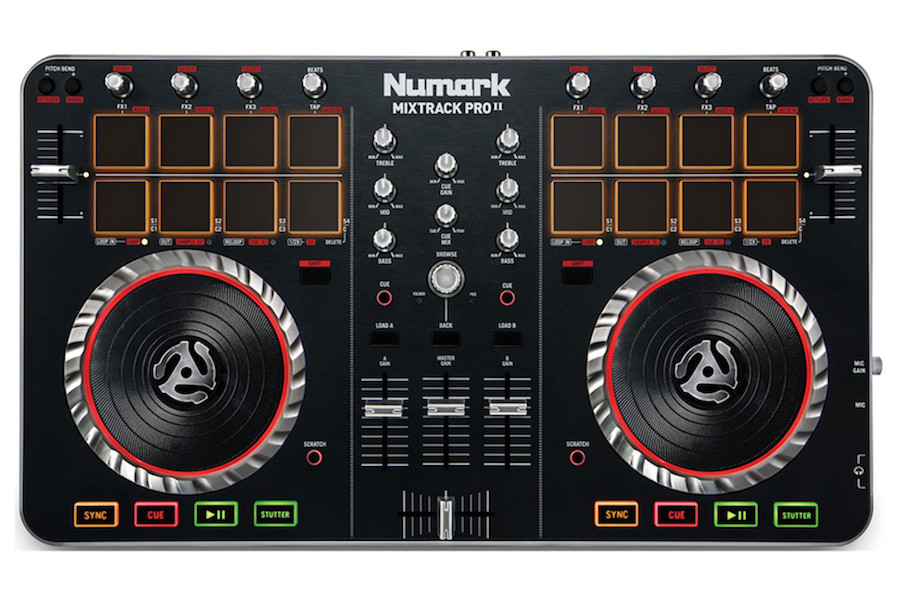
The box contains the NUMARK MIXTRACK PRO 2 itself, a few small paper user guides, and a USB cable for connection to your computer. You’ll need to provide an audio cable to connect an amp and speakers to its RCA outputs, a pair of headphones, and a Windows or Mac laptop.
There’s not even any software in the box – you’re expected to get online to download it. This is actually fast and easy, and there’s no need to register a licence or anything like that. Once the software is downloaded and installed, you plug in the unit and open the software (Serato DJ Intro) and you’re ready to go. It is truly the simplest setting up procedure out there, and credit is due to Serato and Numark for making it so.
The unit itself is attractive. Still a practical size and grounded on four sturdy rubber feet, it’s appreciably slimmer than its predecessor. And while it is still made of plastic and clearly built to a budget, its appearance is a lot nicer. The brushed black surface and metallic-painted casing make it feel more expensive than it is. The new, lower-profile bevelled top and curved bottom appear almost Apple-like, and the jogwheels are sturdy and attractive, albeit slightly smaller than those on the original Mixtracks.
The backlit rubber performance pads feel excellent, and appearance-wise the unit’s budget status is only really given away by the cheap plastic fader caps and knobs. As far as inputs and outputs go, it has two headphones sockets (1/8″ and 1/4″), an 1/8″ microphone jack socket with independent volume control, a USB, and twin RCA outs for amp and speakers.
The top of the unit maintains the original Mixtrack Pro’s curious use of three upfaders, one for each deck, and a master volume up the middle. There are no individual channel gain controls or VU meters (the software has autogain anyway, but still…), which again is as the original Mixtrack. Each channel has just a three-band EQ, cue buttons for headphones and a load button.
Up the middle of the mixer are headphones volume / headphones mix knobs, and a stepped rotary encoder with a control button for library browsing. Small LEDs indicate whether you’re browsing a file or a folder. The jogwheels are capacitive. This means they’re touch-sensitive on the top for scratching, a behaviour that can be switched on and off using the “scratch” button. Meanwhile, the edges work for nudging, or fine-adjusting. playback.
Under each jogwheel are four main buttons for transport. There’s the ubiquitous “sync” button, a cue button, a play/pause, and a “stutter” button, which is a variant of cue (sometimes called “CUP” on other controllers). Each deck has a rather short pitch fader, topped with CDJ-style + and – pitch bend buttons. There are four knobs at the top of each deck, which control the effects, and eight dual-colour backlit performance pads, which are used for cues, samples, loops and effects.
Finally, each deck has a “shift” button, and these are used simply to offer another “layer” of control, doubling up what some of the buttons and knobs do.
IN USE
It is always worth remembering that DJ controllers such as this, apart from offering two audio outputs so DJs can separate headphones and speaker outputs (essential for pre-cueing tunes), are basically interfaces for DJ software. So really, how well a controller performs is to a large extent a factor of the software provided with it. In this case, the software provided – Serato DJ Intro – is perfectly OK for basic DJing, and will serve any new DJ well for the time it takes them to get to their their first few performances.